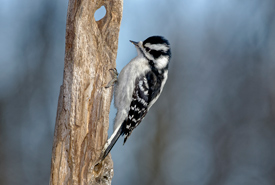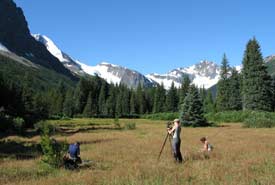Birdwatching apps play a role in conservation

Downy woodpecker (Photo by Lorne)
Wondering what that bird is? Several apps make it easy to answer this question. By entering some data, uploading a photo of the bird or matching its birdsong you can confidently identify birds. Three particular apps — eBird, Merlin and iNaturalist — are also used by scientists all over the world, including those at the Nature Conservancy of Canada (NCC), to get valuable real-time data they can use to protect and manage bird habitats.
eBird Mobile
Before heading out on your next birdwatching adventure, download the free eBird Mobile app from the Cornell Lab of Ornithology.
With eBird, you can record your field observations from anywhere in the world, which are then shared with other birders and scientists. Create a free account on the eBird website, and then use your username and password to log into the app in the field to record your observations. The app works seamlessly offline, so it’s perfect for even the most remote locations. You can access the results from all of your outings on the eBird website, which is also a great tool for planning your next outing based on nearby “hot spots.”
But one of the most exciting features of eBird isn’t what you can do with it — it’s the role that it plays in habitat conservation for the birds you love.
eBird real-time data a boost for NCC scientists
Rebekah Neufeld is the conservation operations program coordinator for NCC’s Manitoba Region. While Rebekah draws from multiple databases and sources in her everyday work, including the Manitoba Conservation Data Centre and Manitoba Breeding Bird Atlas, she finds eBird’s real-time functionality extremely helpful.
“I can go in and check to see if there are new records of species within the last couple of days,” she says. “I would normally have to wait a while to get this information, so it’s definitely a great resource.”
Rebekah uses this data — along with data from other sources — to look for bird observations within the areas where NCC works, which helps inform NCC’s conservation planning and the management of bird habitats on its properties in western Manitoba.
“If we’re working with volunteers and partners, we can use eBird to share data and access each other’s data in real time. This ensures that there is no data loss between different platforms,” says Rebekah.
Rebekah has been using eBird more frequently since 2016, and says that it is “a great equalizer, because it brings together beginners, experts and scientists to share information.” And as she has demonstrated, that data has a very practical use in conservation activities.
Merlin Bird ID: Identifies bird species by photograph
Merlin Bird ID is another app for birders, produced by the Cornell Lab of Ornithology. While eBird is a tool for recording observations and identifying birdsong, Merlin Bird ID enables photo identification of the birds you see on your trip.
Once you’ve downloaded and installed Merlin, you can start out by downloading a bird pack just for the region you are visiting, which reduces the amount of space the app uses on your smartphone. For Canada, you have two choices: eastern and western Canada. You can then upload an image of a bird, and the app will identify the species.
iNaturalist - A generalist app for all wildlife identification
While eBird and Merlin are just for bird sightings, iNaturalist is set up to track and identify everything from insects and fish, to plants and mammals. You can use the databases to save a list of species you have seen, which the app calls your “life list.” You can also submit photos and sound recordings to back up your observations.
“It can be a really fun way to engage with the natural world,” says Mhairi McFarlane, conservation manager for NCC in Ontario. “You can challenge yourself to see how many species you can see over a given time period or in a given area. It can really help identification skills, too; volunteer reviewers check the data you are submitting and provide you with feedback on your identification.”
The power of these platforms lies in the vast number of people who are submitting information. For example, on Global Big Day for birds in 2017 (May 13, 2017), 6,653 bird species — over half of the world’s species — were documented in eBird by 20,259 people around the world!
Scientists are using this information to get a better understanding of bird migration patterns, and conservationists are tapping into it to find out more about where the rare species are, and therefore determine how best to manage habitats. “We can also use the data to document how many people are visiting conservation areas for the purposes of birding or botanizing by looking up the number of checklists or people using eBird, Merlin and iNaturalist,” adds Mhairi.
This post originally appeared on the Nature Conservancy of Canada's Places Worth Protecting microsite and was produced with the support of Randall Anthony Communications Inc.


